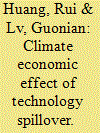| Srl | Item |
| 1 |
ID:
181793


|
|
|
|
|
| Summary/Abstract |
There is increasing interest in the global CO2 emissions transfer caused by international trade. However, the reduction potential of technology spillover is rarely considered. More importantly, the effect of technology spillover on climate change and the social cost of carbon (SCC) should be further investigated to inform climate policy-makers. In this study, we investigate the climate economic impact of technology spillover through unidirectional coupling of the emissions embodied in bilateral trade (EEBT) method and the dynamic integrated model of climate and economy (DICE). The results indicate that technological progress in the electricity sector could contribute to climate change mitigation and SCC lowering. The trade-related CO2 emissions of key CO2 exporters could be substantially reduced, such as China, India, Russia, and resource- and labor-intensive countries. High-tech countries outsourced large amounts of CO2 emissions to labor- and resource-intensive countries. However, a large income gap remains between high-tech and labor/resource-intensive countries. These results indicate the great importance of technological progress and sustainable management throughout the global supply chain.
|
|
|
|
|
|
|
|
|
|
|
|
|
|
|
|
| 2 |
ID:
176898


|
|
|
|
|
| Summary/Abstract |
CO2 emissions embodied in international trade have drawn wide attention in the academia and national climate negotiations. In this study, we estimate the embodied CO2 emissions in the trade between China and Australia using long time series disaggregated sectoral data based on missions embodied in bilateral trade (EEBT) method, and analyse the major driving forces for these emissions changes based on structural decomposition analysis (SDA) method. The results show that export volume contributed to these embodied CO2 emissions increase, while emission intensity could offset these CO2 emissions increase. We further predict embodied CO2 emission in Sino-Australia trade under different scenarios and the results indicate that technology spillover can significantly reduce embodied CO2 emissions in trade. Electricity, transportation and cement industries have significant potential to reduce carbon emissions. In addition, we evaluate future carbon reduction potential till 2030. The results in this study can inform decision-makers for Australia and China to formulate energy conservation and emission reduction policies.
|
|
|
|
|
|
|
|
|
|
|
|
|
|
|
|